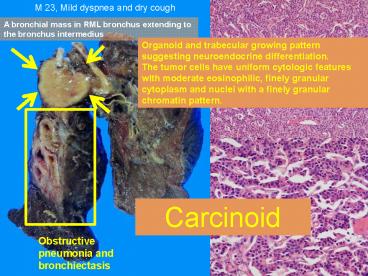M 23, Mild dyspnea and dry cough - PowerPoint PPT Presentation
1 / 3
Title:
M 23, Mild dyspnea and dry cough
Description:
A bronchial mass in RML bronchus extending to the bronchus intermedius ... than two mitoses per 2 mm2 of viable tumor (ten high-power fields) and lacking necrosis. ... – PowerPoint PPT presentation
Number of Views:187
Avg rating:3.0/5.0
Title: M 23, Mild dyspnea and dry cough
1
M 23, Mild dyspnea and dry cough
A bronchial mass in RML bronchus extending to the
bronchus intermedius
Organoid and trabecular growing pattern
suggesting neuroendocrine differentiation. The
tumor cells have uniform cytologic featureswith
moderate eosinophilic, finely granular cytoplasm
and nuclei with a finely granular chromatin
pattern.
Carcinoid
Obstructive pneumonia and bronchiectasis
16248594
2
Carcinoid tumor
- A tumor that is characterized by growth patterns
such as organoid, trabecular, insular,
palisading, ribbon or rosette-like arrangements
which suggest neuroendocrine differentiation. The
tumor cells have uniform cytologic features with
moderate eosinophilic, finely granular cytoplasm
and nuclei with a finely granular chromatin
pattern. Nucleoli may be present but are more
frequent in atypical carcinoids. Carcinoids can
have papillary, sclerosing, follicular and
glandular features. Focal spindle cell and
oxyphilic features are common. Unusual cytologic
features include mucin and melanin production and
prominent nuclear convolutions. Stromal changes
including bone, cartilage, dense fibrosis and
amyloid can be seen. These tumors may be
accompanied by NCH in the airway epithelium,
sometimes associated with airway fibrosis, which
is most often in associated with peripheral
carcinoids. In vary rare cases the underlying
condition of DIPNECH is found, often with
multiple tumorlets and sometimes with multiple
carcinoid tumors
3
Typical carcinoid versus Atypical carcinoid
- Typical carcinoidA carcinoid tumor with fewer
than two mitoses per 2 mm2 of viable tumor (ten
high-power fields) and lacking necrosis. Some of
these tumors show cytologic atypia, increased
cellularity and lymphatic invasion. - Atypical carcinoidA carcinoid tumor with between
two and ten mitoses per 2 mm2 of viable tumor
(ten high-power fields) and/or necrosis, which is
usually punctuate. Other criteria, which are
more subjective include cytologic atypia,
lymphatic invasion, nucleoli, increased
cellularity and disorganized architecture.































